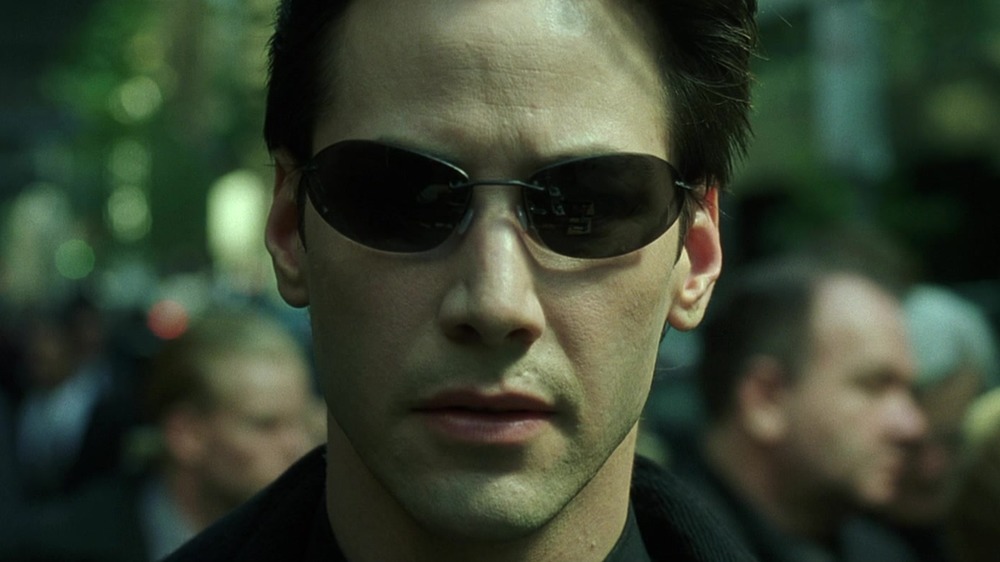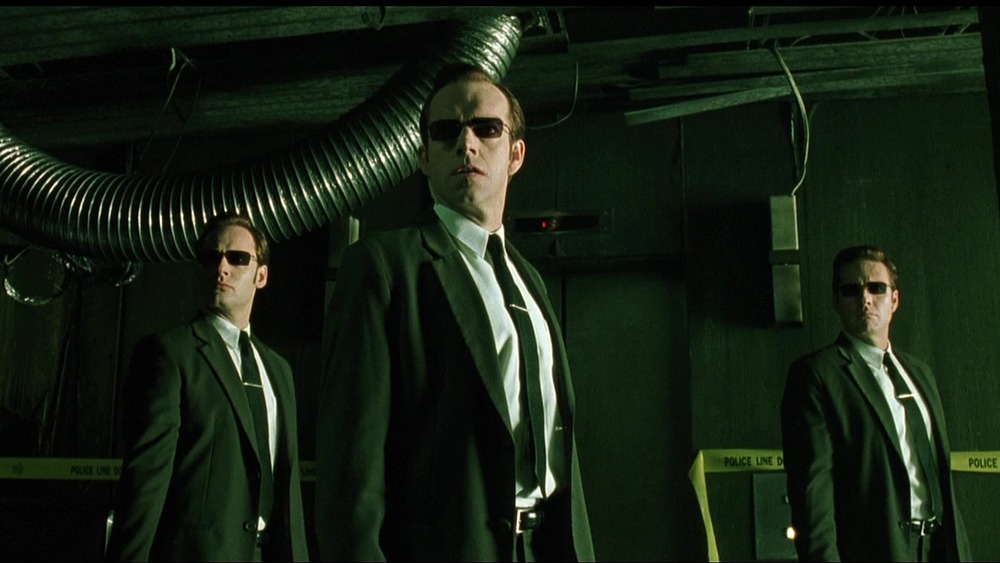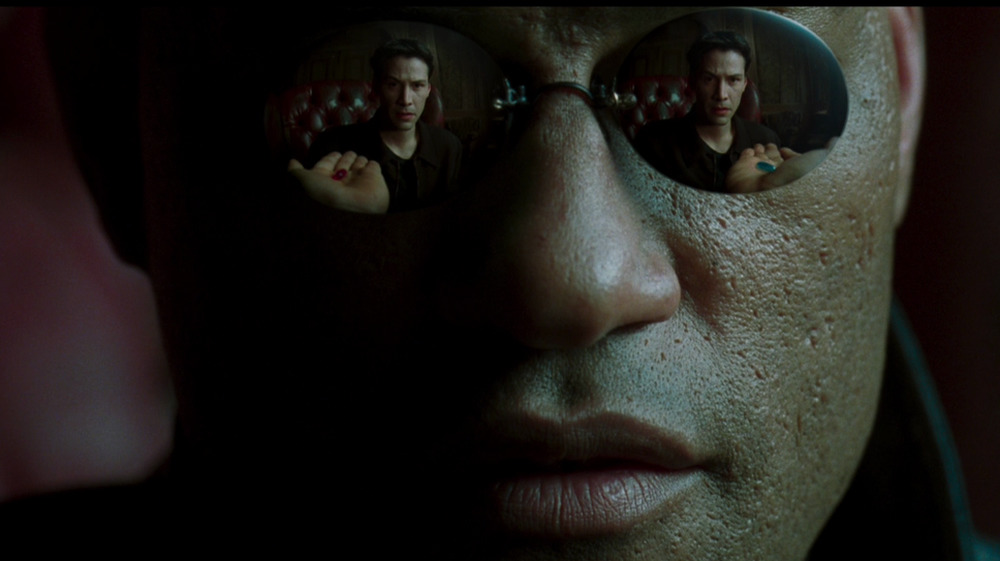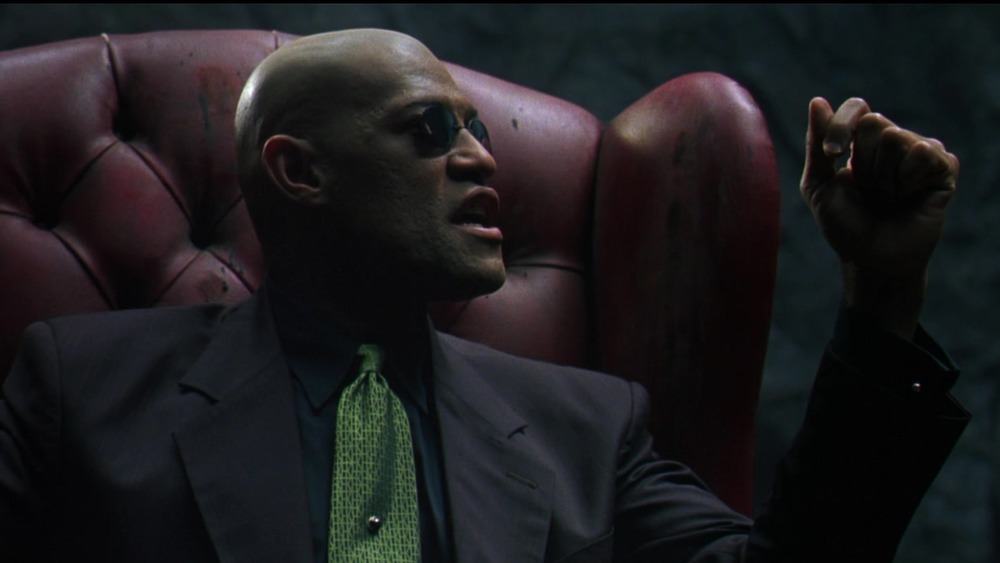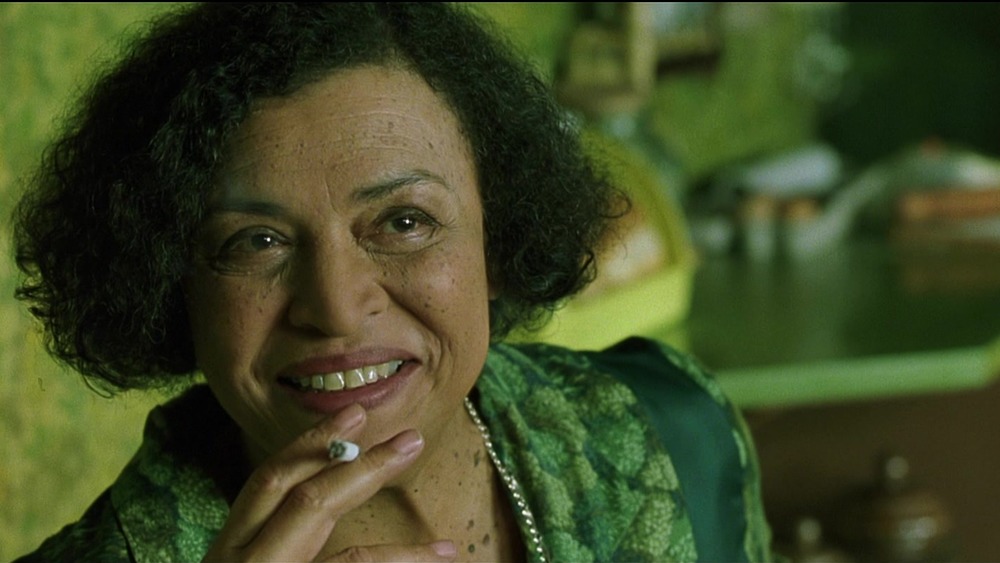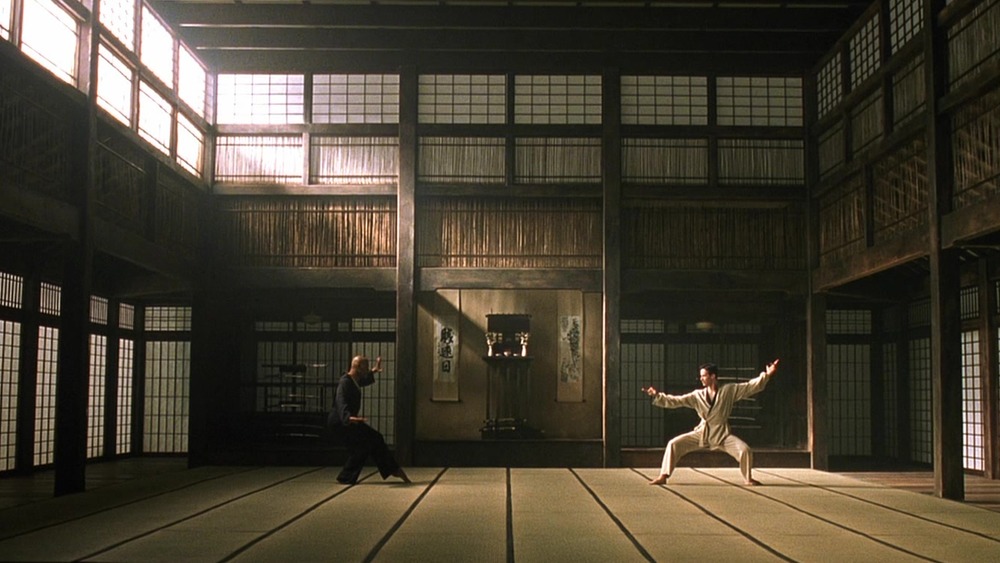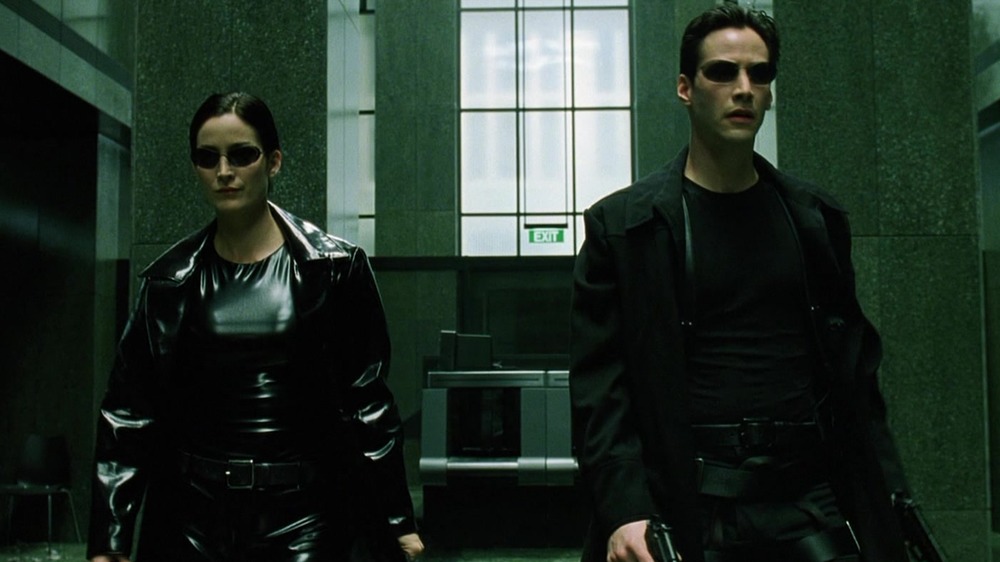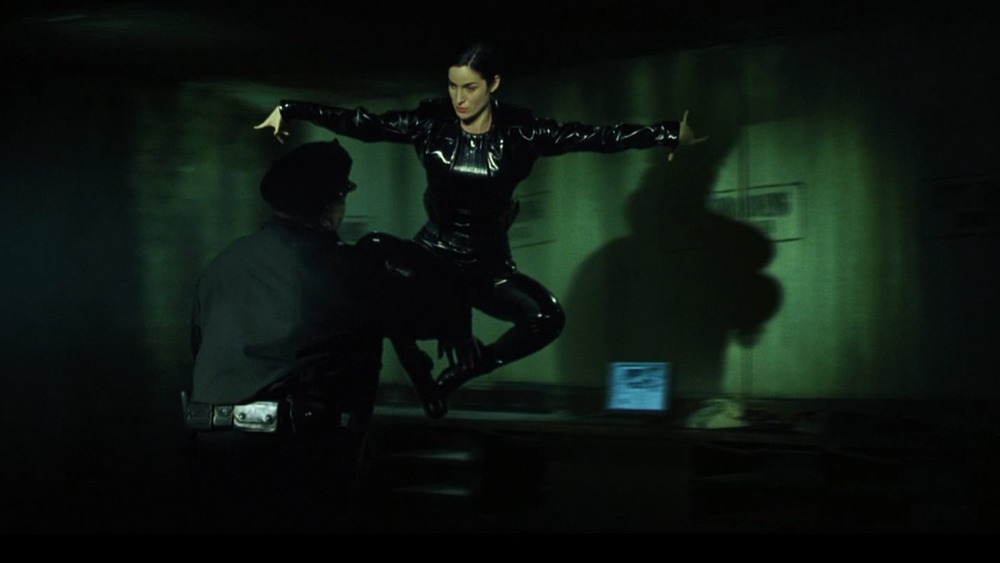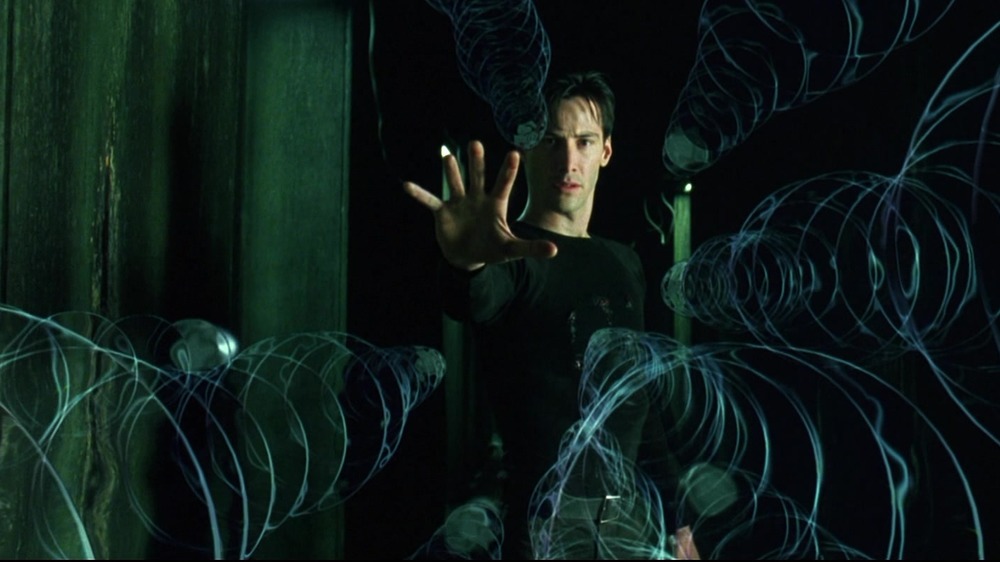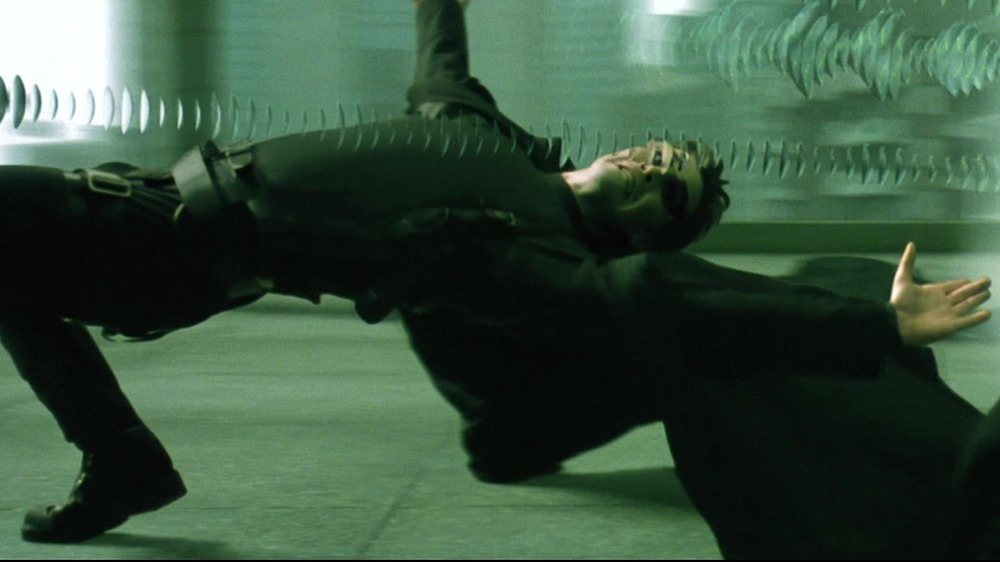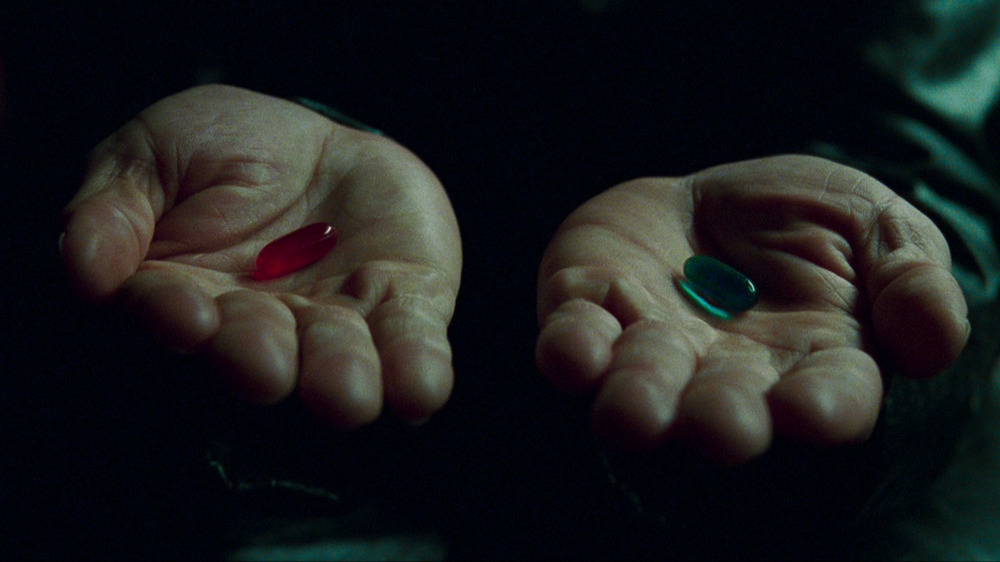Why The Matrix Is The Best Sci-Fi Movie Ever
At the turn of the 21st century, critics and casual filmgoers alike were enthralled by an original sci-fi-action film with dazzling visuals, a hip soundtrack, and an imaginative story. The Matrix, written and directed by relative newcomers Lana and Lilly Wachowski, was the "it" movie of 1999. Its immediate blockbuster success owed a lot to clever marketing: The premise of the film is challenging to encapsulate briefly, so advertisements made that part of the sales pitch. An official website called whatisthematrix.com was launched, and trailers leveraging a cryptic line of dialog claiming that "no one can be told what The Matrix is, you have to see it for yourself" seized cinephile attention.
And see it they did, to the tune of a record-breaking Easter weekend opening. But The Matrix had more going for it than satisfying Super Bowl commercial curiosity. Unsuspecting audiences were not only met with thrillingly innovative action scenes, but also with questions about the nature of existence itself. The Matrix's crossover appeal isn't the result of cold calculation (in fact, studio executives struggled to understand the script, let alone manipulate it), but the natural outcome of visionary filmmakers putting "every idea [they've] ever had in [their] entire lives" into one film.
Thus, The Matrix became an international sensation, and, we believe, the greatest sci-fi movie ever made. Allow us to explain why.
The Matrix expresses complex ideas with unmatched clarity
With the right creators at the helm, science fiction poses deep questions about the world in which we live. For instance, the 2013 sci-fi film Her asks, "What if the voice assistant on your phone was so real and alive that you could fall in love with each other?" This question is a lens through which the film considers the nature of intimacy and the complexities of love and relationships. The imaginary setting allows the audience to detach themselves from some of their preconceptions and look at the issue in question in a new way.
The question posed by The Matrix — "What if the world you think is real is actually an incredibly complex simulation designed to imprison and exploit you?" — is not just a cool premise for a film, it's an incredibly efficient metaphor for the real social, political, and economic forces that set the rules and limits of society. A sci-fi twist on Plato's Allegory of the Cave, The Matrix challenges viewers to consider that they are born into a culture with a set of expectations and conditions that cannot be fully understood from within. How much of what we accept as natural and inevitable is, in actuality, constructed? Who builds those constructs? For what purpose? And, above all: Must things be how they are?
The Matrix contains a firm call to action
The Matrix doesn't only ask big questions — it also presents ways to go about answering them. At the start of the film, Neo (Keanu Reeves) is a computer programmer whose life is empty, but not in jeopardy. It's only his urge to learn the source of that emptiness — the truth of his enslavement — that puts him in danger. When he first meets Morpheus (Laurence Fishburne), Neo is given a choice: He can continue to live in ignorance and relative comfort, or he can choose a path that leads to greater understanding but also greater hardship. The heroes of the story are those who choose to understand the horror of their reality and fight to free others from it. The villains are the Agents who maintain the system, and Cypher (Joe Pantoliano), who knowingly betrays the resistance in exchange for a return to ignorance and greater status within the system that exploits him.
The Matrix also takes care to explain that, in a system built upon exploitation, there are no neutral parties. As part of a training simulation, Morpheus tells the newly-freed Neo that anyone who remains ignorant of the Matrix is potentially a threat to their own liberation: "Many of them are so inert, so hopelessly dependent on the system that they will fight to protect it." The audience is forced to ask themselves, "Is he talking about me?"
The Matrix never feels like homework
Sci-fi films can be slow and cerebral, and there's nothing wrong with that. But there's something to be said for a movie that can do the intellectual heavy lifting of a Blade Runner with the swift pace of a Raiders of the Lost Ark. The Matrix is a top-notch action movie on top of being science fiction — even a viewer who is disinterested in engaging with the film philosophically can still have a great time.
This also increases the likelihood of reaching an audience that might resist the idea of a "political film" (as if any film isn't). Many movies are incredibly transparent, even at the marketing level, as to what their message is. It's obvious from the opening minutes of District 9 that it's intended as a critique of racism and caste systems, for example, and a viewer who wants to "keep politics out of their movies" may simply check out, leaving the film to preach to the choir.
The Matrix has a lot to say, but it says it using eye-popping visuals and action. A movie that talks at you has limited value. A movie that gets you talking when you're done watching has done its job. No other film offers such a perfect balance between sugar and medicine.
The Wachowskis had absolute clarity of vision
The Matrix is as much of an auteur affair as Hollywood blockbusters get. Warner Bros. gave directing duo Lana and Lilly Wachowski a great deal of creative freedom to produce their dream project, a screenplay WB had purchased from them years earlier. The studio didn't understand it at first, but rather than attempt to simplify the script, the Wachowskis collaborated with comics artists Geof Darrow and Steve Skroce and illustrator Tani Kunitake to adapt the screenplay into a 400-page comic book. The film was finally greenlit on the strength of this comic, which is essentially a storyboard for the finished film.
Once production began, the Wachowskis shot scenes with near-telepathic efficiency, often walking cast and crew through takes with Lilly holding a viewfinder and Lana standing in for actors, as depicted in the documentary The Matrix Revisited. While the film is the product of two directors, by all accounts Lana and Lilly presented a totally united front — throughout behind-the-scenes materials and retrospective interviews, it's rare to find any example of an idea being attributed to only one or the other. So certain were the Wachowskis of their vision that they habitually shot only the exact set-ups they intended to use in the final product, with no "coverage" angles for safety. By the time footage got to the cutting room, The Matrix had already taken shape.
The Matrix is a perfect marriage of diverse influences
If there's a knock against The Matrix, it's that the film is not as original as it's hyped up to be. There were, in fact, several films with a similar premise and overlapping themes produced around the same time, including Dark City in 1998, and eXistenZ and The Thirteenth Floor in 1999. The Wachowskis were not the only filmmakers mining the contemporary cyberpunk genre for story ideas. But part of what makes The Matrix stand above its peers is its fusion of ideas from cyberpunk novels like William Gibson's Neuromancer with a host of other influences.
As recounted in The Matrix Revisited, the Wachowskis essentially combined all of their interests in The Matrix. The premise is built off of cyberpunk literature, philosophical texts such as Simulacra and Simulation by Jean Baudrillard, and acclaimed anime like Ghost in the Shell (from which The Matrix admittedly cribbed a few images wholesale). Coming from a background in comics, the Wachowskis wanted to infuse The Matrix with that medium's ability to freeze and examine moments of time, a concept they executed by combining Hong Kong martial arts and wire-fu with the visual effects innovation we now call bullet time. The resulting whole is a product greater than the sum of its parts, but also a gateway into exploring any of the above influences.
It's easy to imagine yourself in The Matrix
The best speculative fiction transports audiences to another world. For example, Star Wars owes much of its longevity to its setting, a lived-in galaxy populated by soldiers, sorcerers, and outlaws. Fans can place themselves in that world, and not necessarily through role-playing as an existing character, but as a version of themselves that belongs there. The Matrix makes this type of imagination a literal part of the setting.
The "real world" of The Matrix is bleak and terrifying, likely far less appealing than the one in which the audience lives — but it's still quickly recognizable, with well-defined looks for the machine world and the rebel hovercraft Nebuchadnezzar. This world has its own rules, roles, and intricacies (further explored in the sequels), but it's also the gateway back into the Matrix itself. While the Matrix is a prison for those still under the Machines' thrall, those who are free can reenter as badass action hero versions of themselves, complete with a sleek outfit, downloaded skills, and the ability to perform impossible feats of agility. While the stakes for them are real and incredibly high, the heroes of The Matrix indulge in the power fantasy right along with the audience.
Plus, thanks to Kym Barrett's iconic costume designs, you can easily imagine what the Matrix version of you would look like, and probably accomplish it with clothes from off the rack.
The fight scenes help tell the story
A sci-fi setting can be more than a physical place — it can also be somewhere with different physical laws. Thus, sci-fi films can use the specific rules of their worlds to depict action sequences that could not exist in any other film. The Matrix doesn't just feature a unique style of action as part of the artifice of the film — it's also part of the movie's deepest themes.
To stage the martial arts sequences, the Wachowskis hired legendary Hong Kong film director and fight choreographer Yuen Woo-ping. As seen in The Matrix Revisited, Yuen worked with each of the four lead actors to develop a fighting style to suit their strengths and convey their character. The fight sequences would also be augmented using wire-fu techniques that allow the characters to hang in mid-air, run up walls, and make superhuman leaps off of the ground — but only in a simulated world, never in the real one.
The use of wirework in the action of The Matrix is incredibly cool, but it also helps to enunciate the themes of the film. The more Neo sheds his lifetime of programming regarding what he's capable of, the less physical laws can affect him in the Matrix and the more otherworldly his movements become. Morpheus and Trinity (Carrie-Anne Moss) can also bend the rules, proving that you don't have to be the One to become stronger through defiant self-belief.
The Matrix has groundbreaking effects that were built to last
The dawn of the 21st century was an exciting time for special effects. Computers were introducing new visual possibilities, but were not yet powerful or affordable enough to become the first-choice solution over practical, in-camera effects. Rather than create a host of completely computer-generated effects shots, most of the stunning visuals in The Matrix were achieved using practical effects, augmented by CGI.
The Wachowskis and visual effects coordinator John Gaeta were very wise in choosing when to rely heavily on CGI. Most of the obvious uses of CGI in The Matrix are obvious on purpose, occurring in moments when the unreal nature of The Matrix is exposed. Take the slow-motion sequences, in which bullets produce dramatic ripples as they slice through the air. It doesn't look real at all, but that's okay — the bullet isn't real, and neither is the air around it. The artificiality is the point.
The signature visual effect of The Matrix, bullet time, is a combined practical-digital effect that encapsulates this unique approach. Bullet time is created by using an array of still cameras around a real subject that capture images in rapid succession. Those images are then combined with a digital environment. Thus, bullet time happens when characters leverage their awareness of their unreal world: In their eyes, the falseness of the world should show through.
The Matrix made an instant, lasting cultural impact
A great film is great whether or not anyone sees it, but when making the case for the best sci-fi movie of all time, being a smash hit certainly doesn't hurt. The Matrix is an original, R-rated sci-fi film from a pair of relatively unknown filmmakers that went on to gross over $463 million worldwide, making it the fourth-highest grossing film of 1999. It won Academy Awards for Best Film Editing, Best Visual Effects, Best Sound, and Best Sound Editing, sweeping the categories in which it was nominated. In 2012, it was inducted into the Library of Congress film registry.
Upon its release, The Matrix immediately became a pop cultural phenomenon. The bullet time fight sequences, which became a symbol of the film, were mined for parody, with Deuce Bigalow: Male Gigolo taking a swing at it in theaters only a few months after The Matrix was released. Scary Movie had an extended Matrix fight sequence the following year. By 2001, Matrix gags had even become prevalent in media targeted at kids too young to see the movie, from Shrek to The Fairly OddParents. These scenes were parodied so frequently in the early 2000s that it became as tired as "Luke, I am your father" gags in a fraction of the time. Annoying? Maybe. A mark of just how iconic The Matrix became at breakneck speed? Absolutely.
The Matrix has aged extremely well
Over 20 years after its release, The Matrix holds up spectacularly. While the period in which it was made shows through in its fashion and the technology of the "real world," the movie's stylized, sideways-from-reality feel keeps it from feeling dated. Even the visual effects are strategically stylized in a way that survives as "retro cool" (see: Tron) rather than "old and busted" (see: Star Wars: Attack of the Clones).
Fans and scholars continue to pick through The Matrix for discussions of philosophy, or as a recognizable device to study unjust social structures, as in 2020's essential Caste: The Origins of our Discontent. In the years since both Wachowski sisters came out as trans women, The Matrix films have become subject to further exploration as a transgender narrative, which Lilly Wachowski has acknowledged and encouraged.
The themes of The Matrix are universal. Philosophers have been questioning the nature of reality for millennia, so it's a subject that's unlikely ever to go out of style. As technology plays an ever-larger role in our lives, we'll always be on the lookout for that moment when machines "start thinking for [us]," even after that moment is passed. And, sadly, as long as we have systems of hierarchy, control, and oppression — particularly when they're hard to see — The Matrix will always be a useful and energizing parable.
